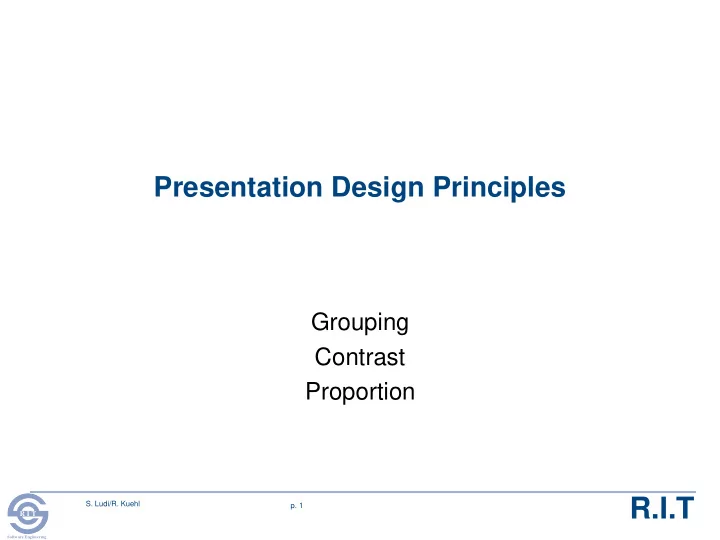

Presentation Design Principles Grouping Contrast Proportion R.I.T S. Ludi/R. Kuehl p. 1 R I T Software Engineering
Usability Presentation Design Framework Properties – color, size, intensity, metaphor, shape, … Navigation Object Object Object Object Text … Icon, Menu Object Object Image, Video Text … Icon, Menu Image, Video Presentation Layout Presentation Layout Object Object Object Object Grouping Grouping R.I.T S. Ludi/R. Kuehl p. 2 R I T Software Engineering
Presentation Simplicity Simplicity guidelines in graphic design … Remove whatever isn’t essential Use a regular pattern for elements, limit variation – same font, color, size, … Combine element roles – e.g., label as a link Balance, symmetry, alignment White space Provide white space margins around objects to avoid crowding Crowding impacts scanning Balance with need to use screen real estate R.I.T S. Ludi/R. Kuehl p. 3 R I T Software Engineering
R.I.T S. Ludi/R. Kuehl p. 4 R I T Software Engineering
Grouping: Gestalt Principles of Perception • Gestalt psychology strives to explain the factors involved in the way we group things :-) Perception of the environment as whole entities even without complete information Distinguish foreground objects from background The Rubin The viewer looks for the simplest solutions Face/Vase even when visually information is incomplete Illusion “Gestalt psychology tries to understand the laws of our ability to acquire and maintain meaningful perceptions in an apparently chaotic world. The central principle of gestalt psychology is that the mind forms a global whole with self- organizing tendencies.” Wikipedia R.I.T S. Ludi/R. Kuehl p. 5 R I T Software Engineering
Gödel Escher Bach: An Eternal Golden Braid R.I.T S. Ludi/R. Kuehl p. 6 R I T Software Engineering
M. C. Escher (1898-1972) R.I.T S. Ludi/R. Kuehl p. 7 R I T Software Engineering
Reversing Staircase Hering Illusion R.I.T S. Ludi/R. Kuehl p. 8 R I T Software Engineering
Bongard Problems What are the pattern rule differences between the left and right columns? A Bongard problem is a kind of puzzle invented by the Russian computer scientist Mikhail Moiseevich Bongard, probably in the mid-1960s. R.I.T S. Ludi/R. Kuehl p. 9 R I T Software Engineering
Grouping Gestalt perception principles are useful to guide the placement and organization of screen elements; e.g., icons, structure menu items Proximity Area Similarity Symmetry Common Fate Surroundedness Closure Prägnanz Good Continuity R.I.T S. Ludi/R. Kuehl p. 10 R I T Software Engineering
Gestalt Principles of Perception Proximity Principle – Objects that are close to each other will be seen as belonging together Equidistant Horizontal Proximity Vertical Proximity R.I.T S. Ludi/R. Kuehl p. 11 R I T Software Engineering
Gestalt Principles of Perception Proximity - Adobe PhotoShop Preferences Dialog R.I.T S. Ludi/R. Kuehl p. 12 R I T Software Engineering
Gestalt Principles of Perception Similarity Principle – Objects that have similar visual characteristics , such as size, shape or color will be seen as a group and therefore related Columns of Similar Objects R.I.T S. Ludi/R. Kuehl p. 13 R I T Software Engineering
Gestalt Principles of Perception Common Fate Principle – Objects that move together (beginning, direction, end) are seen as related Unaligned Drop-Down Menus Aligned Drop-Down Menus O O X XX O OXOOXOXXXOO X O OX O (Similarity) (Common fate) R.I.T S. Ludi/R. Kuehl p. 14 R I T Software Engineering
Common Fate Metaphor R.I.T S. Ludi/R. Kuehl p. 15 R I T Software Engineering
Gestalt Principles of Perception Closure Principle – We tend to see things as complete objects even though there may be gaps in their shape Good Continuity Principle – We tend to see things as smooth, continuous representations; e.g., tendency to perceive a line continuing its established direction R.I.T S. Ludi/R. Kuehl p. 16 R I T Software Engineering
Gestalt Principles of Perception The Area Principle – Objects with small area tend to be seen as the figure , not the (back)ground (also called the smallness principle) R.I.T S. Ludi/R. Kuehl p. 17 R I T Software Engineering
Gestalt Principles of Perception Surroundedness Principle – An area that is surrounded will be seen as the figure and the area that surrounds will be seen as the ground R.I.T S. Ludi/R. Kuehl p. 18 R I T Software Engineering
Gestalt Principles of Perception Prägnanz Principle – we tend to order our experience in a manner that is regular, orderly, symmetric, and simple An overarching principle evolved from the combination and interaction of the other principles Avoid conflicts of principles Similarity vs. common fate or surroundedness perception R.I.T S. Ludi/R. Kuehl p. 19 R I T Software Engineering
Contrast Visual stimulus via contrast – we perceive visual differences of an object before its meaning 1 3 5 7 2 4 6 8 7 5 3 1 4 6 6 2 Visual variables – visual dimensions of perception Selective – single value of the variable can be distinguished in the visual field – locate at a glance Bertin, Graphics and Graphics Information Processing, 1989 R.I.T S. Ludi/R. Kuehl p. 20 R I T Software Engineering
Contrast Find all letters on the left Find all red letters Find all K’s Easiest, hardest? R.I.T S. Ludi/R. Kuehl p. 21 R I T Software Engineering
Contrast in Design Choose appropriate visual variables Use as much range as possible (e.g., small to large) Variable values that make distinctions obvious Multiple variable reinforcement ; e.g., bold and color Use the squint test R.I.T S. Ludi/R. Kuehl p. 22 R I T Software Engineering
Proportion Proportion – relative size E.g. – heading element hierarchy (this slide!) Golden ratio – found in nature, pleasing visual proportions = 1.618 R.I.T S. Ludi/R. Kuehl p. 23 R I T Software Engineering
Recommend
More recommend